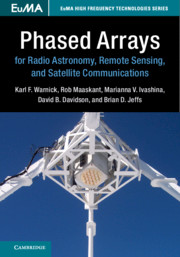Book contents
- Frontmatter
- Contents
- Preface
- Acknowledgements
- Notation and Units
- 1 Phased Arrays for High-sensitivity Receiver Applications
- 2 Active Antenna Receivers
- 3 Antenna Examples
- 4 Transmitting Arrays, Network Analysis, and Pattern Overlap Integrals
- 5 Array Receiver Theory and Modeling
- 6 Figures of Merit for Active Receiving Arrays
- 7 Design and Optimization of Phased Array Antennas
- 8 Numerical Modeling of Phased Array Antennas
- 9 Analog Front End, Array Elements, and Receiver Electronics
- 10 Array Signal Processing, Calibration, and Beamforming
- 11 Interferometric Arrays and Synthesis Imaging
- 12 Real Time Digital Signal Processing
- Index
- References
8 - Numerical Modeling of Phased Array Antennas
Published online by Cambridge University Press: 14 July 2018
- Frontmatter
- Contents
- Preface
- Acknowledgements
- Notation and Units
- 1 Phased Arrays for High-sensitivity Receiver Applications
- 2 Active Antenna Receivers
- 3 Antenna Examples
- 4 Transmitting Arrays, Network Analysis, and Pattern Overlap Integrals
- 5 Array Receiver Theory and Modeling
- 6 Figures of Merit for Active Receiving Arrays
- 7 Design and Optimization of Phased Array Antennas
- 8 Numerical Modeling of Phased Array Antennas
- 9 Analog Front End, Array Elements, and Receiver Electronics
- 10 Array Signal Processing, Calibration, and Beamforming
- 11 Interferometric Arrays and Synthesis Imaging
- 12 Real Time Digital Signal Processing
- Index
- References
Summary
Computational electromagnetics (CEM), the numerical solution of Maxwell's equations, is now a well-established field [1]–[3]. Growing steadily from pioneering work in the 1960s, a range of commercial CEM tools is now available.Well known general purpose software packages in the field are FEKO (Altair), HFSS (Ansys), and Microwave Studio (CST); specifically for reflector analysis, GRASP (TICRA) is a leading code. There are also many public domain codes available, with the venerable NEC-2 code among the most popular. From the perspective of the underlying algorithm, the most widely used methods are the method of moments (MoM), finite element method (FEM) and the finite difference time domain method (FDTD). Many textbooks on computational electromagnetics are available; a basic introduction to FDTD, MoM, and FEM can be found in [4].
Large, broadband aperture and phased array antenna systems can have characteristic dimensions beyond the size that commercial modeling tools can accommodate within a reasonable computation time or memory requirement. Array antenna systems exhibit multiscale features and include both dielectric and metal materials, and elements in the array are strongly coupled. Simulations over a wide range of frequencies and beam scan angles must be considered, and for PAFs the model must include a large reflector. In particular for PAFs, edge effects are important, so analytical infinite array approximations have limited value and full wave techniques are required. Given the computationally intensive nature of the analysis, optimization of astronomical antenna systems by evaluating the entire structure in full detail is challenging.
For radio astronomy applications in particular, designers try to minimize the inclusion of significant volumes of dielectric material in the phased array antennas, to avoid the losses which dielectrics usually bring with them. As a result, the MoM is usually the most efficient technique, as it handles highly (or perfectly) conducting antennas in a very efficient formulation, and using surface or volume equivalence, dielectric materials can be included in the analysis. Since many commercial software packages are built around FEM and FDTD, it is also common for these methods to be used in the design of antenna systems for high sensitivity receiver applications.
- Type
- Chapter
- Information
- Publisher: Cambridge University PressPrint publication year: 2018
References
- 1
- Cited by

